M. Louisa Locke's Blog, page 12
August 25, 2013
Would a Rose by any other Name: The Thorny Question of Titles
I have belonged to a writing group for nearly 25 years, and I cannot count the number of hours we have discussed the titles for our books over those years. For those members who were fortunate enough to be traditionally published (remember those days of yore when it was assumed that a traditional contract was the height of good fortune), the titles they came up with were always tentative because we weren’t ever sure they would be permitted to use them. In fact, when I think of the laughter that erupted as we threw out–often absurd––suggestions, I wonder if this was because we all had the sense that the agents and editors (the “grown-ups” who would instruct us what a good title should be), would have the final word. As a result, I think we felt that we didn’t need to be too serious in the endeavor or that at the very least we shouldn’t ‘fall in love’ with any title because it would break our hearts to have that title eventually rejected by those grown-ups.
But now, as an indie author, I am the grown up. And for better or worse, my book and story titles are entirely my own creation. Today, I thought I would reveal just what went into my choices.
By the time I decided to self-publish the first book in my historical mystery series, I had the benefit of those decades of brainstorming titles and a clear idea of what I needed to consider. First of all, I knew to choose a title that hadn’t already been used. I knew that titles, like covers, should convey the tone of a book and its genre or subgenre. Finally, as I read about the growing importance of online book retailers and search optimization, I concluded that a subtitle for my series with appropriate keywords would be a good strategy.
My decision to use the subtitle, “Victorian San Francisco” in all my books and short stories came after some thought. I had to discard my first ideas: “Gas Lamp,” “Gilded Age,” and “Victorian” because Victoria Thompson, P. J. Ryan, and Robin Paige had already taken these subtitles for their successful historical mystery series. That is when I decided to combine San Francisco with Victorian. Unlike “Gilded Age,” Victorian is a historical term that is known outside the U.S. However, by adding San Francisco, I would ensure that no one would buy the book expecting the story to be set in foggy England. What has been an unexpected benefit to this choice is that foggy, gas-lit San Francisco turns out to be a place that a lot of readers want to visit. I now had my subtitle.
 Maids of Misfortune, the first book in the series, my protagonist, Annie Fuller, widowed boarding house keeper and pretend clairvoyant, goes undercover as a domestic servant in order to ferret out the truth behind the mysterious death of a well-respected merchant.
Maids of Misfortune, the first book in the series, my protagonist, Annie Fuller, widowed boarding house keeper and pretend clairvoyant, goes undercover as a domestic servant in order to ferret out the truth behind the mysterious death of a well-respected merchant.
The title had to be related to domestic service but not sound so academic, so I settled on “Maids.” I made the word plural since there were several servants in the book, one whose eventual fate was very unfortunate. So, Maids of Misfortune became the title. In addition to alluding to the female occupation, this title had enough alliteration to make it sound like a novel (not a scholarly treatise). At the same time, while the word “Misfortune” hinted that something bad was going to happen, it fit with the cozy tone of the mystery. Massacre of the Maids, for example, would not have conveyed what I wanted to convey!
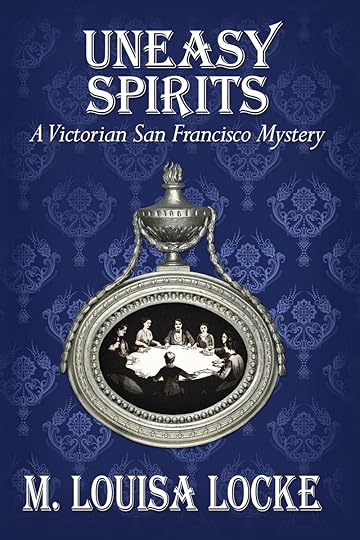 The second book in my series, Uneasy Spirits, explores 19th century “trance mediums” who purported to communicate with the dead, another one of those female-dominated occupations of the 19th century. The title satisfied all my requirements. “Spirits” referred to the occupation and the plot, “Uneasy” reflected the cozy tone, and the title had the alliteration that makes it memorable.
The second book in my series, Uneasy Spirits, explores 19th century “trance mediums” who purported to communicate with the dead, another one of those female-dominated occupations of the 19th century. The title satisfied all my requirements. “Spirits” referred to the occupation and the plot, “Uneasy” reflected the cozy tone, and the title had the alliteration that makes it memorable.
Next, came my two short stories, Dandy Detects and The Misses Moffet Mend a Marriage. Here, I confess that my sense of fun comes into play. The intention of these stories is to let some of the minor characters of my novels have their day. The stories are only tangentially mysteries (which is why the subtitles are “Victorian San Francisco Story,” and the alliteration is so over the top because I hope readers will get the hint that these stories are even more humorous in tone than the full-length novels.
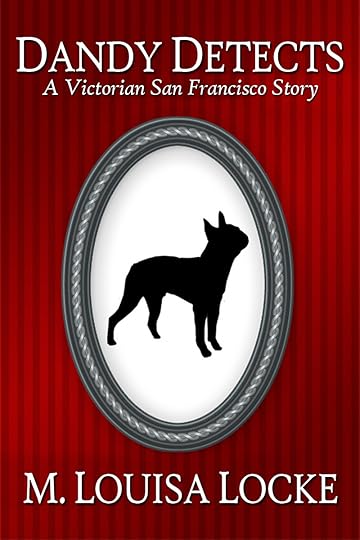 “Dandy” refers to one of my favorite characters, the Boston terrier who lives in Annie’s boarding house and provides comic relief in all my books. “Detects” refers to the fact that in this story he has the starring role in uncovering a crime.
“Dandy” refers to one of my favorite characters, the Boston terrier who lives in Annie’s boarding house and provides comic relief in all my books. “Detects” refers to the fact that in this story he has the starring role in uncovering a crime.
 The title of the second story, The Misses Moffet Mend a Marriage, despite the extreme alliteration, is actually a succinct description of the plot. Additionally, it references the occupation of Miss Minnie and Miss Millie Moffet, the two elderly dressmakers who are the featured in this story. And, this title makes me laugh.
The title of the second story, The Misses Moffet Mend a Marriage, despite the extreme alliteration, is actually a succinct description of the plot. Additionally, it references the occupation of Miss Minnie and Miss Millie Moffet, the two elderly dressmakers who are the featured in this story. And, this title makes me laugh.
I am currently doing research for my next short story, and I hope those of you who have asked if the Chinese servant who played an important role in Maids of Misfortune is ever going to reappear will be glad to learn that the tentative title for this story is Mr. Wong Rights a Wrong.
 Which brings us to Bloody Lessons, the title of my forthcoming new novel due out September 15. When you read the book (it is now available for pre-order and you can read an excerpt here), you will see that the female occupation that I feature this time is public school teaching––hence the word “Lessons” in the title. I also had in mind the fact that in this story a number of characters have some particularly difficult “lessons” to learn about life. As for “Bloody,” well, that is pretty obvious. Some of those lessons will be life threatening. And, as you should have gathered by now, I do have that fondness for alliteration.
Which brings us to Bloody Lessons, the title of my forthcoming new novel due out September 15. When you read the book (it is now available for pre-order and you can read an excerpt here), you will see that the female occupation that I feature this time is public school teaching––hence the word “Lessons” in the title. I also had in mind the fact that in this story a number of characters have some particularly difficult “lessons” to learn about life. As for “Bloody,” well, that is pretty obvious. Some of those lessons will be life threatening. And, as you should have gathered by now, I do have that fondness for alliteration.
For those of you who are authors, I would love to hear how you go about choosing your titles. Was there ever a title you loved, but someone kept you from using it? For readers, when you see my titles, do they convey to you what I intended? –M. Louisa Locke
BLOODY LESSONS COUNTDOWN: 21 days until book launch, 15, 2013! You can pre-order for print and Kindle here.
August 19, 2013
Announcements: Take 2
Guess I was a little sleepy this am, as I tried to post and alert you all to the fact that I had written a piece on another website. No title, then bad link. Sigh..Have had my cup of tea and I am going to try again. Sorry for the confusion—M. Louisa
Over on my “home away from home,” the website, Historical Fiction eBooks, I have posted an article today, entitled: “The story in History is important: Why I write historical fiction.” Do check it out here.
Meanwhile, my forthcoming book, Bloody Lessons, is not only available for pre-order for the Kindle and in print, but I have also put it up as a GoodReads Giveaway.








Announcements
Over on my “home away from home,” the website, Historical Fiction eBooks, I have posted an article today, entitled: “The story in History is important: Why I write historical fiction.” Do check it out here.
Meanwhile, my forthcoming book, Bloody Lessons, is not only available for pre-order for the Kindle and in print, but I have also put it up as a GoodReads Giveaway.








August 15, 2013
Bloody Lessons: One Month until Launch!
 Bloody Lessons, the third book in my San Francisco Mystery Series will be available in print and in all major ebook stores September 15, 2013. The book is already available for pre-order in print on Amazon.com and for the Kindle. See Excerpt.
Bloody Lessons, the third book in my San Francisco Mystery Series will be available in print and in all major ebook stores September 15, 2013. The book is already available for pre-order in print on Amazon.com and for the Kindle. See Excerpt.
♣♣♣♣
In the next month I will be posting frequently about the steps I have been taking to make this a successful book launch and the historical context of this book and Victorian San Francisco.–M. Louisa Locke
Book Description
In Bloody Lessons, it’s the winter of 1880, and the teachers of San Francisco are under attack: their salaries slashed and their competency and morals questioned in a series of poison pen letters.
Annie Fuller, the reluctant clairvoyant, has been called into investigate by Nate Dawson, her lawyer beau, and the case becomes personal when they discover that Laura, Nate’s sister, may be one of the teachers targeted for attack.
In this installment in the Victorian San Francisco Mystery series, readers will find the same blend of a cozy mystery with romantic suspense, played out against the historical backdrop of late 19th century San Francisco, that they found in Maids of Misfortune and Uneasy Spirits.
If you are new to this series, you will still enjoy spending time with the lively residents of Annie Fuller’s boarding house and visiting San Francisco when Golden Gate Park was filled with horse-drawn carriages, saloon-keepers controlled politics, and kisses were stolen under gaslight.








July 4, 2013
Celebrating Independence Day as an Independent Author
 I just wanted to note that I count the July 4, 2010 holiday as my independence day as an indie author. It was that weekend that the Kindle Nation Daily offered my newly written short story, Dandy Detects, as a featured “Kindle Short.” At this stage of the “ebook revolution” there were very few places an indie author could promote her work, and I was very grateful for the opportunity. I had published my first historical mystery, Maids of Misfortune, just over 6 months earlier and I had sold 268 copies in the US Kindle store. I had made enough in sales of both the ebook and print copies to cover my costs (mostly professional covers for my novel and short story), but my sales were not nearly enough to let me quit my day-job (part-time teaching, which supplemented my retirement income.)
I just wanted to note that I count the July 4, 2010 holiday as my independence day as an indie author. It was that weekend that the Kindle Nation Daily offered my newly written short story, Dandy Detects, as a featured “Kindle Short.” At this stage of the “ebook revolution” there were very few places an indie author could promote her work, and I was very grateful for the opportunity. I had published my first historical mystery, Maids of Misfortune, just over 6 months earlier and I had sold 268 copies in the US Kindle store. I had made enough in sales of both the ebook and print copies to cover my costs (mostly professional covers for my novel and short story), but my sales were not nearly enough to let me quit my day-job (part-time teaching, which supplemented my retirement income.)
Then came that Kindle Short promotion over the July 4th holiday. As hoped, people who read the short story on the Kindle Nation Daily website went on to buy the novel, and over that weekend I sold over 70 copies of Maids of Misfortune (an enormous number in those days) pushing it to the top of the historical mystery bestseller list and making me a mover and a shaker on Amazon for a day. Maids stayed on the top of that list for the next year and a half, and since Amazon.com had just made the option of getting 70% royalties for books selling at $2.99 and above, I made enough money in that time to truly become an independent author, quitting my part-time teaching job to become a full-time author.
As a professional historian I am well aware of how complicated the issues are that surround the divining the “true” meaning of our nation’s independence movement, just as I am aware of the complex issues involved in defining what it means to be an independent author. But in very simplistic terms, in the past two years I have made more each year in sales than I made at the peak of my career as a community college professor (which might also indicate how much our nation values higher education–but that is another whole topic). This has given me the freedom to write what I want and to spend time helping other authors achieve independence from the traditional route to publishing. And for that, I celebrate the day.
M. Louisa Locke, July 4, 2013








July 2, 2013
Copperfield Review Interview
Meredith Allard has just posted an interview with me at the The Copperfield Review–A Journal for Readers and Writers of Historical Fiction that you might find interesting. The Copperfield Review is an electronic journal that reviews historical fiction (including poetry), and historical non-fiction, as well as does interviews with historical fiction authors. I found the questions very thought-provoking, and I appreciated the chance to write a little more about my journey as a historical fiction author and my participation in the Historical Fiction Authors Cooperative.
You can find my interview here.
M. Louisa Locke, July 3, 2013








May 24, 2013
“It’s a Dandelion Thing:” Social Media and Marketing
At the Digital Minds Conference held before the 2013 London Book Fair, Neil Gaiman made a speech where he asked the question: “How do we make ourselves heard in a world of too much information?” His answer: We rely on becoming dandelions.“
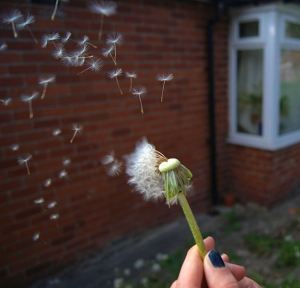 Gaimen went on to say: “…the model is try everything. Make mistakes. Surprise ourselves. Try anything else. Fail. Fail better. Succeed in ways we would never have imagined a year ago or a week ago. I think it’s time for us to be dandelions willing to launch a thousand seeds and lose 900 of them if a hundred or even a dozen survive and grow and make a new world.”––Neil Gaiman, Transcript of Speech at Digital Minds Conference for London Book Fair 2013
Gaimen went on to say: “…the model is try everything. Make mistakes. Surprise ourselves. Try anything else. Fail. Fail better. Succeed in ways we would never have imagined a year ago or a week ago. I think it’s time for us to be dandelions willing to launch a thousand seeds and lose 900 of them if a hundred or even a dozen survive and grow and make a new world.”––Neil Gaiman, Transcript of Speech at Digital Minds Conference for London Book Fair 2013
I love this image of the dandelion and its seeds, and it helped me frame what I wanted to say about my particular strategies regarding marketing and social media.
Like most committed indie authors, I have read innumerable blog posts about how to use social media to sell my work. I have read that I must blog, use facebook, pinterest, tumblre, google+, linkedin, stumbleupon, and reddit, among other things, (don’t you just love some of those names?). I have read that if I am going to blog I should do it daily, with short pieces, and lots of pictures, that I should tweet at least 5 times a day, but never actually promote my own books through twitter, that I should get involved on GoodReads groups but never engage in BSP (blatant shameless promotion), that I should take blog tours, that I should… Well you get the picture. I have also read that I shouldn’t do any of the above, but I should just write more books.
My conclusion after several years of reading about social media is that there are countless paths to getting your work visible through social media, and that there are no guarantees that any particular path is going to work, or assurance that the paths that work today will still be effective next month, or next year. Myspace anyone?
I think this is why I resonated so much to Gaimen’s speech and his exhortation to experiment and to do so with the expectation that many, if not most, of our efforts will, like dandelion seeds, fail to take root. This reflects my own experience and my own temperament as an indie author.
For example, when I started my blog, I called it my Front Parlor, thinking this was a clever way to establish a brand for my planned series of Victorian San Francisco Mysteries. I expected this blog to be the main path to finding the audience of potential readers for my historical fiction. Instead, my posts turned out to attract mainly an audience of other authors, who are probably quite mystified by that “Front Parlor” reference.
In addition, contrary to the perceived wisdom that successful blogs need frequent, short posts accompanied by pictures, it is my long, infrequently posted, picture-less blog pieces on topics like choosing the right categories, KDP Select, and marketing that keep being read, linked to, and commented on. For example, my first post on the importance of choosing categories has been read by over 10,000 people.
 Seeds were sown, and took root, just not the ones I had planned on. Sort of like planting tulips and getting tomato vines instead.
Seeds were sown, and took root, just not the ones I had planned on. Sort of like planting tulips and getting tomato vines instead.
But, that doesn’t mean I have given up on tulips. I am trying to include more and more historical posts that will be of interest to readers, not just writers, but only time will tell if those historical posts bear fruit. (I know, I know, tulips don’t bear fruit, but I never met a mixed metaphor I didn’t like.)
Twitter, on the other hand, is not a place where my seeds flourish much at all. 140 characters? I can’t write a blog piece under 2000 words, how am I expected to say anything in 140 characters? I used twitter when I first signed up to find bloggers who seemed to be writing interesting pieces on ebooks and self-publishing, and I still use twitter as a way of letting my own followers know when I write a blog piece, find an interesting article by someone else, or to help cross-promote my own and my friends’ books. But my number of followers is relatively small, the percentage of my followers who retweet my tweets is miniscule, and most of those who do, are fellow authors, not the people reading my books. Again, as with my blog, I haven’t found twitter a fertile place to connect with fans or potential fans of my work. And, as most bloggers seem to agree, for social media to work there has to be a sense of personal connection.
On the other hand, most of my seeds on GoodReads seem to grow on their own. I have my author page, I gladly accept anyone who wants to be a friend, and I find the giveaways useful in letting people know when a new book is out. But in most cases, it is readers themselves who sow my seeds. Without my asking, they put my books on their shelves and review them. For example, Maids of Misfortune has been rated by 755 people and 944 people have it on their too-read list, which feels like a nice lush garden, just not sown by me.
In fact, the dandelion metaphor really works well when considering my activities on sites like GoodReads, Shelfari, or LibraryThing, or the various genre specific sites like Historical Fiction Mysteries, Cozy Mystery.com, or sites that feature indie authors like Awesome Indies, or indieBrag, or the numerous book bloggers. I am willing to sign up, get my books listed, offer an occasional post, give an interview, scatter some of those dandelion seeds. What I don’t do is spend time cultivating them so they must take root on their own if they are to survive.
Time is the big factor here. For example, GoodReads members don’t want authors to pop into group discussions just to promote their books. They want authors to engage in conversations over the books or topics they are discussing. Yet, at this point in my writing career, I can’t find the time to read the books that are being discussed on groups like Historical Fictionistas. So any activity on my part on these groups would be inauthentic. I can scatter seeds in lots of places, but I haven’t the time to really cultivate them in most of the places they land.
For me, that sense of authentic connection has only come recently, and I am as surprised as anyone that it has come on Facebook.
As a good little indie author, even before I set up a website, I signed up for a private Facebook page. I loved that I found old high school friends and acquaintances (who were some of the first to buy Maids of Misfortune when it came out––thank you all!) I still enjoy the fact that I often know what my nieces and their children are up to before my sister-in-law does because I check out Facebook several times a day. But any fans who wander onto this site aren’t going to hear much from me of interest on a day-to-day basis. I am too private (or maybe just too long-winded) to burble on during the day about my daily affairs, I don’t really think that other writers or fans want to see too many pictures of my grandchildren (adorable though they may be.), and it seems inconsiderate to impose too much of my writing business on friends and family. So some seeds do grow there, but again, not with much cultivation on my part.
However, several months ago, when I started to report my word count on the author Facebook page I had set up, I discovered my seeds were falling on very fertile ground and I didn’t mind cultivating them.
My author Facebook page is where the most vocal fans of my series seemed to show up. It was here that I would get questions about when the next book in my Victorian San Francisco mystery series was going to show up. So, several months ago I decided if I announced how many words I had written (or if I wrote at all) in a day to people who actually cared about the new book being published, I would try harder to put my writing first. And it worked. I spent more days writing and I spent more hours per day, and in two months I wrote 76,000 words and completed the first draft.
In addition, in order to make these updates more interesting, I began talking about the research I was doing and linking to websites about historical places, events, and people that were relevant. I even found a way to use Pinterest when I discovered I could easily link my updates to picture I had pinned (without worrying about copyright-since the picture was linked back to its origins.)
And people, people who were not just other authors, responded. They cheered me on when I had a high word count, and they consoled me when I didn’t. They commented on the links and added their own, and they shared personal stories. That personal connection that I had been missing on twitter, my blog, and GoodReads was suddenly there.
 I have no idea whether the seeds I am sowing on this Facebook page will have any significant effect on future sales. For all I know, everyone who has participated would have gone out and bought the next book anyway. But that doesn’t matter because I just enjoy going out every day and looking at all the pretty splashes of yellow in that particular field.
I have no idea whether the seeds I am sowing on this Facebook page will have any significant effect on future sales. For all I know, everyone who has participated would have gone out and bought the next book anyway. But that doesn’t matter because I just enjoy going out every day and looking at all the pretty splashes of yellow in that particular field.
And when you come down to it, isn’t that what it is all about. Writing the books, telling the stories, and basking in the knowledge that other people have enjoyed sharing with you the worlds you have created.
Now all you authors, do tell me where you have scattered your seeds, and where you have found they have taken root most successfully. And for the readers among those reading this post, where have you found the most satisfying personal connections to the authors you love?
In case you are interested, Maids of Misfortune, the first book in my Victorian San Francisco Mystery Series will be free on Kindle May 25-26, 2013.








April 12, 2013
Review of Rubies of the Viper
 Rubies of the Viper is a fast-paced, suspenseful and romantic historical novel by Martha Marks, and a totally satisfying read. Set primarily in Rome at the time of Emperor Nero, Rubies of the Viper tells the story of Theodosia, who is a young single woman without family to guide or protect her when she suddenly inherits her family fortune at the death of her half-brother. The mystery surrounding that brother’s death, the confusion of competing suitors, the secrets surrounding her own background, the machinations of unknown enemies, and her conflicted relationship with her household slaves keep Theodosia off balance and in danger throughout the book. I loved how Marks accurately recreated the past, portraying the complicated social, economic, and political relationships of the Roman Empire through the relationships of the characters, while making me see, and smell, and feel the urban bustle of the metropolis and the cool luxury of a villa. However, my favorite element in the book is how Marks not only fully realized her main protagonist, Theodosia, but her development of the secondary protagonist, Alexander, a Greek slave. I learned to love these two characters, care about their futures, and look forward to seeing them in future novels.
Rubies of the Viper is a fast-paced, suspenseful and romantic historical novel by Martha Marks, and a totally satisfying read. Set primarily in Rome at the time of Emperor Nero, Rubies of the Viper tells the story of Theodosia, who is a young single woman without family to guide or protect her when she suddenly inherits her family fortune at the death of her half-brother. The mystery surrounding that brother’s death, the confusion of competing suitors, the secrets surrounding her own background, the machinations of unknown enemies, and her conflicted relationship with her household slaves keep Theodosia off balance and in danger throughout the book. I loved how Marks accurately recreated the past, portraying the complicated social, economic, and political relationships of the Roman Empire through the relationships of the characters, while making me see, and smell, and feel the urban bustle of the metropolis and the cool luxury of a villa. However, my favorite element in the book is how Marks not only fully realized her main protagonist, Theodosia, but her development of the secondary protagonist, Alexander, a Greek slave. I learned to love these two characters, care about their futures, and look forward to seeing them in future novels.
Rubies of the Viper will be Free on Kindle April 12-14.
Review of No Game for a Dame and Tough Cookie: A Gendered Twist on the Classic Detective Genre
 As any one who has read my own work might guess, I enjoy historical mysteries with a strong female protagonist who is working. And, therefore, it is no surprise how delighted I was when I found M. Ruth Myer’s mystery series featuring Maggie Sullivan, a sassy female detective.
As any one who has read my own work might guess, I enjoy historical mysteries with a strong female protagonist who is working. And, therefore, it is no surprise how delighted I was when I found M. Ruth Myer’s mystery series featuring Maggie Sullivan, a sassy female detective.
I initially gave the first book in Myer’s series, No Game for a Dame, a try because I am a fan of the hard-boiled detective mysteries of Raymond Chandler and Dashiell Hammett that are set in the 1930s and 1940s. And boy, am I glad I did. What fun it was to see the classic themes of this genre played out with a female private eye, in a book that stayed absolutely faithful to the historical time and place, late 1930′s Dayton, Ohio.
In No Game for a Dame Myers did a lovely job of developing the classic uneasy relationship between a private detective (in this case Maggie Sullivan) and the local police. But she has woven in the added element of paternalism on the part of those older Irish cops in their treatment of the daughter of one of their former colleagues. Myers also carried through this gendered take on the genre by having Maggie use women, who were scrabbling for a way to make a living in the depths of the Great Depression, as her major sources of information in pursuing her investigation into a string of robberies.
The mystery in No Game for a Dame was compelling, the secondary characters fully developed, and the possible romance between Maggie and one of those Irish cops was just enough to make me want more.
Which is why I was delighted when the next book in the series, Tough Cookie came out. In this sequel, Maggie Sullivan starts out with a missing person case that turns quickly to murder, and I was again swept away to the late 1930s mean streets of Dayton, Ohio.
Tough Cookie (which can be read as a stand alone) has all the elements you look for in a hard-boiled mystery: good old-fashioned detective footwork, a wealthy client, a ditzy dame, loyal servants, smooth-talking lotharios, hard liquor bottles in the desk drawer, fast cars, and gun-play. I couldn’t put the book down, and while I guessed “who done it,” I didn’t care, because I was having so much fun, right down to the end that totally surprised me. Needless to say I am looking forward to the next book in the series.
For more about M. Ruth Myers and her other works of fiction, please check at HFeBooks.com. And, as an extra benefit, No Game for a Dame will be free on Kindle April 12-14.


April 6, 2013
Historical Fiction that Influenced Me
I have decided to start putting up reviews on my blog. These will be primarily of interest to those people who are fans of my Victorian San Francisco Mystery series and might therefore be interested in what books I like to read. I remember how Dana Stabenow in one of her earliest Kate Shugak mysteries listed the books in Kate’s cabin. I assumed they reflected Stabenow’s own literary tastes, which were very similar to my own, and I remember thinking this was one of the reasons I enjoyed these mysteries set in the Alaskan wilderness so much. So I thought that readers might enjoy getting a glimpse into what literature influenced me, and conversely be influenced to pick up some of these books to read for themselves.
This first post is a repost of an article I did for the HFeBooks.com blog about the books that influenced my decision to write historical fiction. While not strictly a review, I thought it might be a good way to start out these series of reviews. When I wrote this post I was startled to realize the enormous effect the books I read as a child had on both my thirty-year career as a history professor who specialized in social and women’s history and my second career writing my Victorian San Francisco Mystery series (see Maids of Misfortune and Uneasy Spirits).
I was a voracious reader as a child, and my mother took me every week to the huge Carnegie Library in the next township so I could check out enough books to get me through to the next week. It was the 1950s and early 60s, and there were no local bookstores in my neighborhood, no Amazon.com, and most of the books in my house were either my mother’s childhood books or the books I got as presents for birthdays and Christmas.
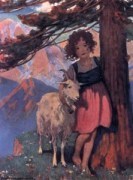 I probably read thousands of library books in my youth, but my favorites were the hardbacks my family owned, that my parents read to me, that I learned how to read from, and that I read over and over. In fact, these favorites are sitting up on the shelves of my study still today.
I probably read thousands of library books in my youth, but my favorites were the hardbacks my family owned, that my parents read to me, that I learned how to read from, and that I read over and over. In fact, these favorites are sitting up on the shelves of my study still today.
 These books are Johanna Spyri’s Heidi (set in the 1870s Alps), Louisa May Alcott’s Little Women (set in late 1860s Boston) Laura Ingalls Wilder’s Little House on the Prairie series (set in 1870s Wisconsin, Kansas, and the Dakota Territory) Kate Seredy’s The Good Master and The Singing Tree (set in Hungary in the period right before and during WWI), and Lucy Fitch Perkin’s Spartan Twins (about a girl and a boy living in 5th century Greece).
These books are Johanna Spyri’s Heidi (set in the 1870s Alps), Louisa May Alcott’s Little Women (set in late 1860s Boston) Laura Ingalls Wilder’s Little House on the Prairie series (set in 1870s Wisconsin, Kansas, and the Dakota Territory) Kate Seredy’s The Good Master and The Singing Tree (set in Hungary in the period right before and during WWI), and Lucy Fitch Perkin’s Spartan Twins (about a girl and a boy living in 5th century Greece).
While most of these books don’t fit the narrow definition of historical fiction (that the work be set in a time period more than fifty years earlier or be written by someone who was not alive during the time period covered in the work), to a young girl growing up in a 1950s American suburb, all of them were stories from the very distant past.
To show the direct connection between my childhood reading and my choices as an historian and writer, let’s look specifically at what all these books have in common. First of all, they all describe in meticulous detail the material culture of the families in each book. For example, in Wilder’s Little House in the Woods, I experienced through little Laura’s eyes the everyday task of churning butter, the steps taken to turn a live pig into sausages, and how to make maple syrup. In the next book in the series, Little House on the Prairie, I learned about how dangerous it was to cross swollen streams in a covered wagon, what it felt like to have been raised in a place of hills and trees and to find yourself in a sea of grass with nothing between you and the sky, and I read about how Laura’s parents constructed a log cabin from scratch.
In Kate Seredy’s The Good Master, which introduced Jansci and Kate, two young Hungarian children, I read about the lives of sheep herders, the importance of horses to Hungarian plainsmen, how to decorate Easter eggs and the daily chores connected to milking cows and raising chickens. Then in Heidi I got to spend a day in the mountains with goats and imagine what the golden goat cheese would taste like. In the Spartan Twins, Dion and Daphne watched their mother spin wool, helped keep the birds from the ripening fields, and Dion, like Kate, stole sausages that certainly sounded tastier than the sausages I ate. Louisa May Alcott’s Little Women didn’t portray a rural society, but her Civil War era Boston felt even more foreign to me than the rural scenes of Wilder or Seredy as I read about young girls who fixed baskets for the poor, wore complicated and uncomfortable clothing and hairstyles, and, even though they were “poor,” had a servant named Old Hannah who seemed to do most of the work.
All these childhood books, while they described the lives of children who lived in different centuries in different parts of the world, helped me feel a connection to the people of the past. I recognized in these books that whether it was by candlelight or oil lamps, parents in every age got frustrated with their children, children from every part of the world got into trouble, and families of every culture passed on their wisdom and beliefs through stories, and poetry, and song.
Besides their focus on the details of every day life, these favorite childhood books also featured young women as the main protagonists, the second element my early childhood reading had in common. These stories were a revelation to a young girl in 1950′s America. As an adult, I can see that these books, most of them written in the late 19th century, reinforced the ideas of gender roles of their period. Women and girls did domestic chores in the home or around it, and men and boys worked with livestock, hunted, and worked the fields. A major theme of The Good Master was how Kate first became a tomboy and then learned how to put on her multiple skirts and be a real woman. Jo March and her sisters devoted themselves to the home and steering their neighbor and friend Laurie away from moral temptation. As a child growing up amidst the 1950s Feminine Mystique, I saw these gender roles as perfectly normal and therefore not particularly noteworthy.
However, it was the differences I noticed. I was growing up in a world where fathers disappeared every day to go “down town” to do some mysterious job they never talked about and mothers fussed with what seemed trivial chores like dusting, setting the timer on the oven for a roast, and going “shopping.” Boys knew they could be almost anything when they grew up: doctors, lawyers, dentists, professional athletes, newscasters, mechanics, bankers, engineers, plumbers, construction workers, or university professors. As a girl, however, my future was supposed to be marriage, with maybe a brief stint in the limited occupations of teaching, nursing, or being a secretary. And the history books I read were about men, doing male things, like politics and war.
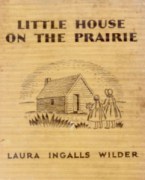 Yet, in my childhood books, women and men worked together, sometimes helping each other, as when Ma and Pa Ingalls built the log house, sometimes doing different jobs side-by-side, as Kate’s aunt spun wool next to her husband who was building chairs, and sometimes running the family by themselves, as Jo’s mother did while her husband was away at war in Little Women. Even the girls in the family contributed. Whether it was Kate doing multiple farm chores, or Laura Ingalls teaching in a rural school to add to the family savings, or Jo March’s “scribblings,” in each of these stories it was abundantly obvious to me as a child that women’s activities were as crucial to the economic well-being of the household as were men’s. This was an alien concept in my middle-class suburbia, and I was intrigued by this vision of a different kind of society with different roles for women.
Yet, in my childhood books, women and men worked together, sometimes helping each other, as when Ma and Pa Ingalls built the log house, sometimes doing different jobs side-by-side, as Kate’s aunt spun wool next to her husband who was building chairs, and sometimes running the family by themselves, as Jo’s mother did while her husband was away at war in Little Women. Even the girls in the family contributed. Whether it was Kate doing multiple farm chores, or Laura Ingalls teaching in a rural school to add to the family savings, or Jo March’s “scribblings,” in each of these stories it was abundantly obvious to me as a child that women’s activities were as crucial to the economic well-being of the household as were men’s. This was an alien concept in my middle-class suburbia, and I was intrigued by this vision of a different kind of society with different roles for women.
So, how did these childhood books affect my subsequent career? First of all, the attention to the detail of ordinary people’s daily life became the kind of history I was interested in as an historian. When I pursued my doctorate in history in the late 1970s, I chose to become what was called a social historian, which meant that I concentrated on studying “history from the bottom up.” I was not the kind of historian that was particularly interested in the “Great Men” of the past. I didn’t focus on political parties, presidential campaigns, kings, parliaments or on wars and military campaigns. Instead, I read and wrote about groups that had seldom appeared in standard history texts: working class men and women, immigrants, the urban and rural poor, African-Americans, and women. I looked at what their lives were like day-to-day (where they lived, what jobs they had, who they spent time with) and analyzed how family and community, and racism, nativism, and sexism impacted their opportunities (or lack thereof). These themes dominated my dissertation, ran through my lectures on U.S. and women’s history, and are woven into my historical mysteries. Anyone who has read my first historical mystery, Maids of Misfortune, should recognize the connection between the sections in that book describing the daily chores done by 19th century domestic servants and the kind of childhood historical fiction I read.
Secondly, when you consider that all of my favorite childhood books were written by women about women, it is not surprising that my dissertation was on women who worked in the west at the end of the 19th century, or that I taught women’s history, or that the books in my Victorian San Francisco mystery series have a female protagonist, look at gender issues, and feature different women’s occupations. As I work on the third book of my series, Bloody Lessons, I even found that Wilder’s excellent descriptions in her Little House on the Prairie series of different schoolrooms were one of the best sources for details on 19th century teaching.
These childhood books had an extraordinarily important influence on the rest of my life. So, this question is for all of the rest of you: what childhood books were important to you and your subsequent love of historical fiction?















